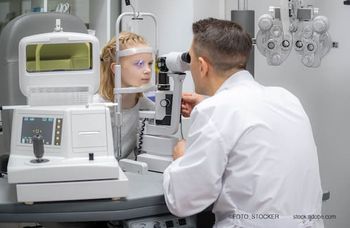
Fungal infections after keratoplasty on upswing
Post-keratoplasty fungal infections are becoming increasing more common, and the risk is significantly higher after DSEK compared with PK.
Reviewed by Anthony Aldave, MD
Los Angeles-Infections after keratoplasty-particularly Descemet stripping endothelial keratoplasty (DSEK)-are on the rise, with the majority of cases being fungal, said Anthony Aldave, MD.
A report from the Eye Bank Association of America (EBAA) identified an increasing trend in the incidence of fungal infections after corneal transplantation between 2005 and 2010.1
Recent:
A recently conducted follow-up study has confirmed a significant increase in the incidence of post-keratoplasty fungal infection.
In addition, “the risk is significantly higher following DSEK than penetrating keratoplasty [PK],” said Dr. Aldave, professor of ophthalmology, Walton Li Chair in Cornea and Uveitis, chief, Cornea and Uveitis Division, and director, Cornea and Refractive Surgery Fellowship, Stein Eye Institute, University of California, Los Angeles.
Research from the EBAA found that two-thirds of all infections were due to fungi, and almost all of those were Candida species.
Related:
The diagnosis of post-keratoplasty interface infections most often occurs 3 to 16 weeks after surgery. The usual signs are focal interface opacities that slowly increase in size and number, Dr. Aldave said.
“Imaging with confocal microscopy to identify the presence of fungi can be very helpful to diagnose the cause,” he said.
An anterior chamber tap can be performed as well, but would likely be negative if the organisms are confined to the donor-host interface following DSEK or Descemet membrane endothelial keratoplasty (DMEK).
More:
Biopsy is another option, although excision of a portion of the donor cornea is probably easier with cases of DMEK than DSEK, he added.
In terms of management, corneal rim cultures that are positive can be helpful to guide therapy, Dr. Aldave advised.
Surgeons should also find out about the mate cornea (the fellow eye donor cornea) to determine if donor corneal rim cultures were performed and whether the recipient developed an infection.
Infiltrates as factor
Management also will depend on the number of infiltrates.
“In the case of a post DSEK or DMEK infection, if the infection looks like it involves the host stroma, removing the donor graft will not eradicate infection,” he said.
A review of literature on post DSEK and DMEK interface infections shows only a small number of case reports or case series, including a total of 23 patients, Dr. Aldave said.
Related:
A small percentage had a positive donor corneal rim culture; 15 were negative. All reported organisms were Candida.
Recipient cultures were performed in 18 of the 23 cases, and all were culture positive.
“The majority of those were Candida, but there were also Staph species and Nocardia. Sometimes, you have to consider a bacterial organism as the cause,” he said.
Among the 23 patients, those treated with topical, intracameral and/or oral antifungal therapy eventually required PK.
However, two patients who received antifungal injections into the interface did not require PK.
Surgical intervention
In regard to surgical intervention, surgeons can consider removal or exchange of the endothelial graft via a posterior lamellar keratoplasty, but keep in mind that surgical manipulation may allow seeding of the organism into the anterior chamber, Dr. Aldave cautioned.
Additionally, of the four eyes that underwent DSEK graft removal to manage the infection, all eventually required a PK, as did two of the three eyes that underwent DSEK exchange.
Related:
As the infection resolved following PK in each of the 10 eyes in which it was performed, Dr. Aldave concluded that a PK appears to be the definitive means to manage an interface keratitis following DSEK.
“If you perform a PK, trephinate a larger diameter than the graft itself so you can excise the host and donor together,” Dr. Aldave said.
Did you know?
Reference
1. Aldave AJ, Dematteo J, Glasser DB, et al. Report of the Eye Bank Association of America Medical Advisory Board Subcommittee on fungal Infection after corneal transplantation. Cornea. 2013; 32:149-154.
Anthony Aldave, MD
This article was adapted from Dr. Aldave’s presentation at Cornea Subspecialty Day during the 2015 meeting of the American Academy of Ophthalmology. Dr. Aldave did not indicate any proprietary interest in the subject matter.
Newsletter
Don’t miss out—get Ophthalmology Times updates on the latest clinical advancements and expert interviews, straight to your inbox.


















































.png)


